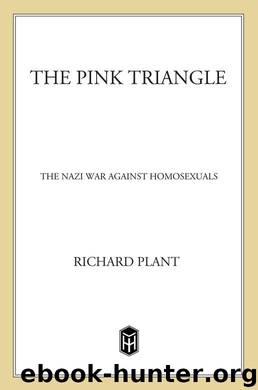The Pink Triangle: The Nazi War Against Homosexuals by Plant Richard

Author:Plant, Richard [Plant, Richard]
Language: eng
Format: epub
Publisher: Henry Holt and Co.
Published: 2011-04-01T00:00:00+00:00
With this, I have slipped into a discussion of the larger drive against the Catholic Church, which started in 1935, culminated in several trials in 1936 and 1937, and continued on a much smaller scale until 1945. The Nazis simply ignored the 1933 concordat with the Vatican. Only in 1937 did Pope Pius XI issue his encyclical “With Burning Anxiety.” It is not possible here to render a complete history of the war the Nazis waged against the German Catholic Church. I must restrict myself to those skirmishes in which the Nazis employed, among other weapons, charges of homosexuality. A few representative incidents will suffice.
Like Hitler, Reichsführer SS Himmler admired the organization of the Catholic Church as much as he loathed its doctrines. Himmler often said he wanted to shape his SS troops into a well-knit elite order embodying many of the superior qualities of the Jesuits. Nevertheless, together with Goebbels, Himmler let loose a defamation campaign against the Catholic establishment which portrayed it as a hotbed of homosexual atrocities.
The Nazis had charged the Catholic Church with assisting enemies of the state to escape to foreign countries; transferring funds illegally outside the Third Reich, especially to the Vatican; committing homosexual felonies, often with minors but also with other clerics; demoralizing the armed forces through pastoral epistles; lending support to the resistance within Germany and in the occupied territories; befriending members of the forced labor battalions in German factories, both directly through distribution of food and clothing, and indirectly through counseling; spreading atrocity stories outside of Germany, mainly through the Vatican; attempting to deny all wrongdoings, hide the perpetrators, and hush up the crimes.
If one of these imputations proved to be impractical, another could be substituted. When trying to pin down a priest, the Gestapo often used combinations of charges, such as illegal money operations and homosexual misdeeds.
Paragraph 175 supplied the basis for many individual anticlerical arraignments, but the most famous witch hunt started in 1935, culminating in two show trials in 1936 and 1937. Here the authorities brought charges of gross indecencies against three groups, almost all residents of such heavily Catholic districts as Bavaria, the Rhineland, Westphalia, and the Palatinate. The first group comprised lay brothers, loosely connected and nominally supervised by the Franciscans; the second included secular clergy, priests serving in various western and southwestern dioceses; the third consisted of members of such orders as the Augustinians and the Franciscans. The battle was really three-sided: the Gestapo, seeking every shred of evidence with unremitting devotion; a frightened judiciary, split among traditional judges, wary of Nazi methods, pro-Nazi careerists, and those who were weak and wavering; and finally, the beleaguered Church. Often, defendants were not permitted to have their own lawyers; evidence was suppressed when it hampered the prosecution attorneys, or distorted or falsified when it furthered their case.
Yet it is astonishing how the clergy, from the two most prominent officials, Clemens August Cardinal von Galen, Bishop of Münster, and Konrad Cardinal von Preysing, Bishop of Berlin—to the local parish priest, put up such tenacious resistance.
Download
This site does not store any files on its server. We only index and link to content provided by other sites. Please contact the content providers to delete copyright contents if any and email us, we'll remove relevant links or contents immediately.
| African-American Studies | Asian American Studies |
| Disabled | Ethnic Studies |
| Hispanic American Studies | LGBT |
| Minority Studies | Native American Studies |
Cecilia; Or, Memoirs of an Heiress — Volume 1 by Fanny Burney(31322)
Cecilia; Or, Memoirs of an Heiress — Volume 3 by Fanny Burney(30928)
Cecilia; Or, Memoirs of an Heiress — Volume 2 by Fanny Burney(30885)
The Great Music City by Andrea Baker(21195)
We're Going to Need More Wine by Gabrielle Union(18064)
Bombshells: Glamour Girls of a Lifetime by Sullivan Steve(13100)
Pimp by Iceberg Slim(12922)
All the Missing Girls by Megan Miranda(12739)
Fifty Shades Freed by E L James(12443)
Norse Mythology by Gaiman Neil(11873)
Talking to Strangers by Malcolm Gladwell(11861)
Crazy Rich Asians by Kevin Kwan(8341)
Mindhunter: Inside the FBI's Elite Serial Crime Unit by John E. Douglas & Mark Olshaker(7827)
The Lost Art of Listening by Michael P. Nichols(6462)
Enlightenment Now: The Case for Reason, Science, Humanism, and Progress by Steven Pinker(6403)
Bad Blood by John Carreyrou(5761)
The Four Agreements by Don Miguel Ruiz(5502)
Weapons of Math Destruction by Cathy O'Neil(5029)
We Need to Talk by Celeste Headlee(4861)
